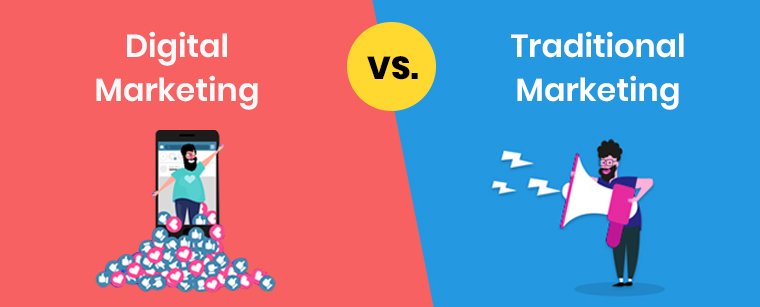The gap between digital marketing and traditional marketing is endless. Every entrepreneur knows that both strategies generate good results considering the concept of each business, however, the digital era expands like gunpowder and brand-consumer interaction is decisive for loyalty, an extra point for digital marketing!
But why is digital marketing more profitable than traditional? Without the desire to detract from traditional marketing (known as offline marketing), it only focuses its mechanism of action on the product or service to encourage sales. On the other hand, digital marketing (or online marketing) uses its action to connect with the user and generate a conversion.
Why Digital Marketing is More Profitable than Traditional Media:
1. Segmentation
- Traditional Marketing: The message is addressed to the masses. General aspects regarding age, sex, location, salary and audience studies are studied.
- Digital Marketing: The interests, behavior in social media and more specific demographic characteristics of the audience are studied. The message is addressed to select segments.
2. The Communication
- Traditional Marketing: It is unidirectional and linear. The user is passive and does not have the ability to generate a response to the company. Promotes a message through mass media to influence public buying behavior.
- Digital Marketing: It is bi-directional and interactive. Build relationships with the company and customers. Promotes credibility among consumers. The company establishes conversations and satisfies the needs of the public.
3. The Profitability
- Traditional Marketing: The entrepreneur hires advertising spaces in the media or on billboards, which involves large investments of money and time.
- Digital Marketing: The entrepreneur hires a digital marketing agency that generates proposals according to his business and his budget.

4. The Positioning
- Traditional Marketing: The presence of a brand is due to the use of traditional channels such as the press, radio, television, events, exhibitions and conferences as well as advertisements or POP printed material
- Digital Marketing: The presence of a brand is due to the Internet and the use of digital channels such as social networks, e-mail marketing, web pages, blogs, applications and online stores.
5. Advertising
- Traditional Marketing: Ads have specific times and places. It takes time to generate customers and buyers. Advertising is invasive and reaches an audience that did not request brand information.
- Digital Marketing: It is easier to generate purchases with just one click. Advertising is less invasive and reaches a specific audience that has confidence in the brand.
6. The Measurement
- Traditional Marketing: The results are not always quantifiable because it is aimed at the masses. It also focuses on the design of offline surveys to study the market, measure customer behavior and study opinions about the brand with long-term results.
- Digital Marketing: The impact of social media; Web 2.0 and 3.0 are measured based on the statistics obtained in digital campaigns. It also focuses on the design of online surveys to study the market, measure user behavior and study opinions on social platforms with results immediately.
7. Loyalty
- Traditional Marketing: The strategies and the action plan is oriented to your sales. The brand is difficult to access for the buyer, he worries about boosting his mission and vision without attending the suggestions of the buyers.
- Digital Marketing: The brand is no longer “untouchable”, worrying about listening to the needs of its community, which improves the connection with the audience.
Characteristics of Digital Marketing and Traditional Marketing
Each of these currents addresses different means, actions and resources that converge on the same point: brand positioning. Let’s see what are the elements to take into account:
The 4C of Digital Marketing

- Content: The creation of valuable content depends on an investigation, knowing how to listen, interacting and knowing the consumers of your brand. The “content is king” as long as it responds to the interests of the audience.
- Community: A community is built freehand, with quality content. Users who visit or share information from your social networks or your website should feel identified with the content. Do not believe in accounts with millions of followers; Create a community that is interested in your message as a brand.
- Connection: The message must be the same in social networks but adapted to the characteristics and functions of each one. Structure that message according to the language, context, community and interaction of digital channels.
- Conversation: Worry about the feedback with your audience. It is useless to push a message unless you get an answer. Listen to the suggestions, talk and win the trust of your community.
The 4Ps of Traditional Marketing

- Product: Define the type of your product such as size, weight and packaging. In addition, it determines what the medium, time and delivery of the product will be.
- Price: Evaluates the raw material that was invested for the elaboration of the product and carries out a market study to then determine the final cost.
- Plaza: Select the place and the channel to promote the sale and distribution of the product.
- Promotion: Choose what will be the traditional means to promote the product.
Why Invest in Digital Marketing?
- The contents and advertisements prevail over time. You can usually modify the message as many times as necessary without generating additional costs.
- Internet advertising does not pollute.
- It is accessible for users and economical for companies.
- Take into account the opinion of the communities.
- The strategies that are developed are measurable. Even if you don’t have a physical headquarters, statistics and your campaigns will yield important data. Analyze them!
“The Internet turned what used to be controlled and unidirectional message into a real-time dialogue with millions of people,” said Danielle Sacks of Fast Company.

